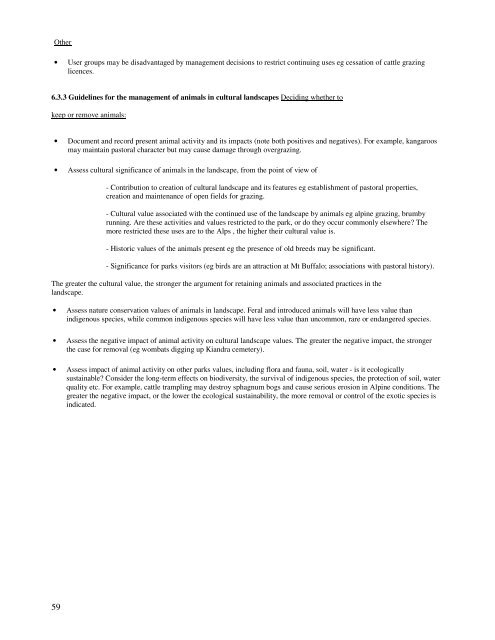Cultural Landscape Management - Australian Alps National Parks
Cultural Landscape Management - Australian Alps National Parks
Cultural Landscape Management - Australian Alps National Parks
Create successful ePaper yourself
Turn your PDF publications into a flip-book with our unique Google optimized e-Paper software.
Other• User groups may be disadvantaged by management decisions to restrict continuing uses eg cessation of cattle grazinglicences.6.3.3 Guidelines for the management of animals in cultural landscapes Deciding whether tokeep or remove animals:• Document and record present animal activity and its impacts (note both positives and negatives). For example, kangaroosmay maintain pastoral character but may cause damage through overgrazing.• Assess cultural significance of animals in the landscape, from the point of view of- Contribution to creation of cultural landscape and its features eg establishment of pastoral properties,creation and maintenance of open fields for grazing.- <strong>Cultural</strong> value associated with the continued use of the landscape by animals eg alpine grazing, brumbyrunning. Are these activities and values restricted to the park, or do they occur commonly elsewhere? Themore restricted these uses are to the <strong>Alps</strong> , the higher their cultural value is.- Historic values of the animals present eg the presence of old breeds may be significant.- Significance for parks visitors (eg birds are an attraction at Mt Buffalo; associations with pastoral history).The greater the cultural value, the stronger the argument for retaining animals and associated practices in thelandscape.• Assess nature conservation values of animals in landscape. Feral and introduced animals will have less value thanindigenous species, while common indigenous species will have less value than uncommon, rare or endangered species.• Assess the negative impact of animal activity on cultural landscape values. The greater the negative impact, the strongerthe case for removal (eg wombats digging up Kiandra cemetery).• Assess impact of animal activity on other parks values, including flora and fauna, soil, water - is it ecologicallysustainable? Consider the long-term effects on biodiversity, the survival of indigenous species, the protection of soil, waterquality etc. For example, cattle trampling may destroy sphagnum bogs and cause serious erosion in Alpine conditions. Thegreater the negative impact, or the lower the ecological sustainability, the more removal or control of the exotic species isindicated.59
















